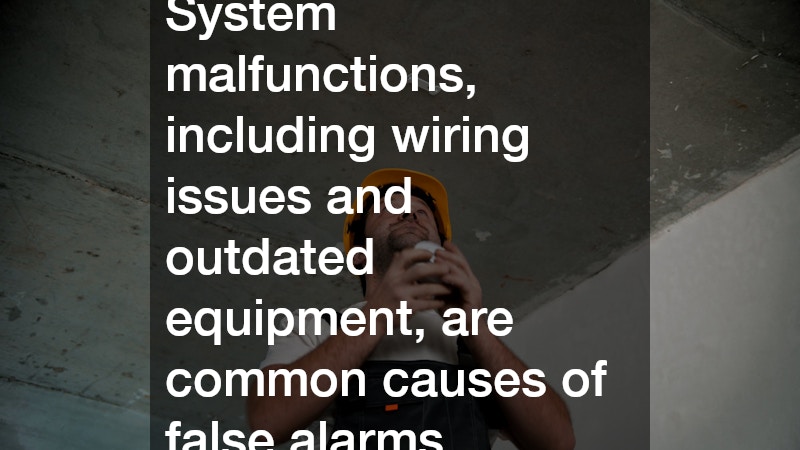Commercial fire alarm systems are an essential component of building safety, designed to protect lives and property from the devastating effects of fires. Understanding how these systems function and the necessary safety tips can ensure they operate correctly and comply with established safety standards. These systems are a critical line of defense, alerting occupants and initiating emergency responses swiftly.
Given this importance, it’s vital to have a comprehensive knowledge of fire alarm system components, maintenance needs, and the correct response procedures during an alarm.
What are the Components of a Commercial Fire Alarm System?
Fire Detection Devices
Fire detection devices form the backbone of any commercial fire alarm system, with smoke detectors, heat detectors, and flame sensors serving as critical elements. Each device has a unique function, with smoke detectors sensing particles in the air, heat detectors responding to significant temperature changes, and flame sensors detecting electromagnetic waves from flames. The effective integration of these devices provides comprehensive coverage against different types of fire threats. For instance, smoke detectors are adept at identifying smoldering fires, while heat detectors are invaluable in environments with high dust or steam levels that could impact smoke detector performance.
Alarm Notification Appliances
Alarm notification appliances, such as horns, strobes, and speakers, play a vital role in alerting building occupants to the presence of a fire. Each type of appliance is designed to ensure that alerts are both audible and visible, reducing the probability of alarms going unnoticed. Horns produce loud sounds that can penetrate through ambient noise, while strobes emit bright lights to catch the attention of individuals who may not hear the auditory signals. Speakers, on the other hand, are crucial for delivering verbal instructions, guiding occupants on proper evacuation protocols.
How Do You Maintain Commercial Fire Alarm Systems?
Regular Testing and Maintenance
Regular testing and maintenance are critical to the reliability and efficiency of fire alarm systems. It is recommended to adhere to a structured schedule, typically monthly and annual checks, to ensure all components are functional and up to code. Testing involves simulating alarm conditions to verify that devices trigger appropriately and notification systems operate optimally. Conducting these tests can identify potential issues early, enabling timely repairs or replacements before actual emergencies arise.
Professional Inspections
Professional inspections by certified technicians are indispensable for maintaining the integrity of commercial fire alarm systems. Experts possess the necessary skills to identify complex issues that may not be apparent during routine checks. Annual inspections conducted by professionals ensure that systems meet current safety standards and are capable of detecting fires accurately and efficiently. Inspectors can also provide recommendations for upgrades or changes to improve alarm performance.
What are the Common Causes of False Alarms?
Environmental Factors
Environmental factors, such as dust, steam, and cooking vapors, frequently contribute to false alarms in commercial fire alarm systems. These elements can trick detection devices into believing there is smoke or heat caused by an actual fire. Periodic cleaning and recalibration of sensors can mitigate the effects of environmental contaminants, reducing the likelihood of false alarms. Implementing precautionary measures detailing how sensors should be protected from these elements is essential for accurate system performance.
System Malfunctions
System malfunctions, including wiring issues and outdated equipment, are common causes of false alarms. Over time, the wear and tear of various system components can lead to unintentional alerts, disrupting normal business activities. Upgrading aging systems and ensuring that wiring is intact and free of corrosion can help avert these false positives. Investing in modern fire alarm technologies that offer enhanced reliability can also prove beneficial in decreasing unnecessary alarms.
What are Some Fire Alarm Safety Tips for Building Occupants?
Understanding Alarm Signals
Educating occupants about alarm signals is crucial for ensuring prompt and effective emergency responses. Each type of alarm sound conveys specific information, making it vital that everyone understands their meanings to react appropriately. For instance, a continuous alarm might signal an evacuation, while a series of intermittent beeps may indicate a different emergency or a malfunction. Familiarizing occupants with these signals facilitates orderly evacuations and prevents confusion during actual emergencies.
Fire Drill Practices
Regular fire drills are an indispensable part of fire preparedness plans, preparing occupants for swift evacuations in the event of a fire. These practices create familiar pathways and establish clear roles and responsibilities during emergencies. Fire drills should simulate real conditions as closely as possible, focusing on efficiency, proper use of exits, and accounting for all occupants once outside the building. By practicing these protocols, occupants gain confidence in their ability to respond correctly during an actual fire.
In summary, commercial fire alarm systems play a crucial role in ensuring building safety by detecting fires early and prompting timely occupant evacuations. Key safety tips, such as maintaining both components and educating occupants, directly impact the systems’ effectiveness.

